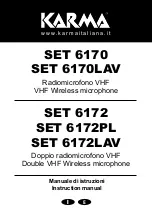
14
2.1 D 409
2.1.1
Connecting the
Microphone to a
Balanced Input
Refer to fig. 1.
2.1.2
Connecting to
an Unbalanced
Input
Refer to fig. 2.
Note:
The D 409 provides a balanced output with a 3-m
(10-ft.) cable and 3-pin male XLR connector:
Pin 1: ground
Pin 2: hot
Pin 3: return
You can connect the microphone either to a
balanced or an unbalanced microphone input.
Fig. 1: Connecting to a balanced input.
1. Plug the XLR connector on the microphone
cable either directly (A) or via an optional XLR
cable (B) to the desired microphone input on
your mixing desk or amplifier.
1. To connect the microphone to an unbalanced
microphone input (1/4” jack), use an extension
cable (1) with a female XLR connector (2) and a
1/4” TS jack plug (3). These cables are avail-
able at music stores.
Unbalanced cables may pick up interference
from stray magnetic fields near power or lighting
cables, electric motors, etc. like an antenna.
This may cause hum or similar noise when you
use a cable that is longer than 16 feet (5 m).
2 Interfacing
B
A
D 409
XLR
D 409
XLR















































